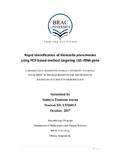Rapid identification of Klebsiella pneumoniae using PCR based method targeting 16S rRNA gene

View/
Date
2017-10Publisher
BRAC UniversityAuthor
Aurna, Sameya TasneemMetadata
Show full item recordAbstract
Background of the study: Klebsiella pneumoniae (KPN) is a gram negative and one of the most pathogenic bacteria of Klebsiella species which accounts for a significant proportion of pneumonia, nosocomial infections, urinary tract infections, intra-abdominal infections, soft tissue infections and septicemia. Current culture-based methods for identifying Klebsiella pneumoniae are time-consuming, not highly sensitive and sometimes inconclusive. The aim of the study is to establish a rapid and specific method for identification of Klebsiella pneumoniae using the 16S rRNA gene based PCR assay as a possible alternative of traditional phenotypic procedures. Methods: A primer set targeting the 16S rRNA gene of Klebsiella pneumoniae was designed using CLUSTALW and Primer-BLAST software. Culture on selective media and specific biochemical tests for Klebsiella pneumoniae, DNA extraction, PCR, gel electrophoresis and finally nucleotide sequencing was used in this study. Eleven stored clinical Klebsiella pneumoniae strains from laboratory stock were examined using the primer set in order to verify the efficiency of the primer. For rapid detection purpose, ten different specimens (wound swab, pus sample) collected in STGG media were examined. DNA was extracted twice from the same specimen; (i) directly from the media- without enrichment and (ii) after 4 hours incubation with enrichment media. Results: The designed primer set correctly detected all eleven KPN strains obtained from laboratory stock. Identification of Klebsiella pneumoniae in direct swab samples and brief cultivation in enrichment broth required ~4h and ~8h respectively after sample reaches to the laboratory to diagnosis. Similar results were obtained from the KPN strains collected from laboratory stock and the strains that were used for rapid detection (collected from wound, pus swab). All the strains amplified a 657bp product of the 16S rRNA gene of KPN as well as suggesting 99% identity with the 16S r RNA gene of Klebsiella pneumoniae by Sanger Sequencing and BLASTn analysis.
Conclusion: The study demonstrates a simple yet useful PCR-based approach for identification of Klebsiella pneumoniae that appeared to be more sensitive, specific and resulted in significant time saving in comparison to traditional phenotypic based methods and can serve as a beneficial tool for the rapid detection of Klebsiella pneumoniae before the infection can progress to acute phase.
